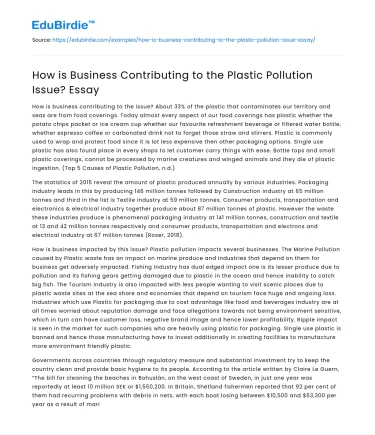How is business contributing to the issue? About 33% of the plastic that contaminates our territory and seas are from food coverings. Today almost every aspect of our food coverings has plastic whether the potato chips packet or ice cream cup whether our favourite refreshment beverage or filtered water bottle, whether expresso coffee or carbonated drink not to forget those straw and stirrers. Plastic is commonly used to wrap and protect food since it is lot less expensive then other packaging options. Single use plastic has also found place in every shops to let customer carry things with ease. Bottle tops and small plastic coverings, cannot be processed by marine creatures and winged animals and they die of plastic ingestion. (Top 5 Causes of Plastic Pollution, n.d.)
The statistics of 2015 reveal the amount of plastic produced annually by various industries. Packaging industry leads in this by producing 146 million tonnes followed by Construction industry at 65 million tonnes and third in the list is Textile industry at 59 million tonnes. Consumer products, transportation and electronics & electrical industry together produce about 87 million tonnes of plastic. However the waste these industries produce is phenomenal packaging industry at 141 million tonnes, construction and textile at 13 and 42 million tonnes respectively and consumer products, transportation and electrons and electrical industry at 67 million tonnes (Roser, 2018).
Save your time!
We can take care of your essay
- Proper editing and formatting
- Free revision, title page, and bibliography
- Flexible prices and money-back guarantee
How is business impacted by this issue? Plastic pollution impacts several businesses. The Marine Pollution caused by Plastic waste has an impact on marine produce and industries that depend on them for business get adversely impacted. Fishing Industry has dual edged impact one is its lesser produce due to pollution and its fishing gears getting damaged due to plastic in the ocean and hence inability to catch big fish. The Tourism Industry is also impacted with less people wanting to visit scenic places due to plastic waste sites at the sea shore and economies that depend on tourism face huge and ongoing loss. Industries which use Plastic for packaging due to cost advantage like food and beverages industry are at all times worried about reputation damage and face allegations towards not being environment sensitive, which in turn can have customer loss, negative brand image and hence lower profitability. Ripple impact is seen in the market for such companies who are heavily using plastic for packaging. Single use plastic is banned and hence those manufacturing have to invest additionally in creating facilities to manufacture more environment friendly plastic.
Governments across countries through regulatory measure and substantial investment try to keep the country clean and provide basic hygiene to its people. According to the article written by Claire Le Guern, “The bill for cleaning the beaches in Bohuslän, on the west coast of Sweden, in just one year was reportedly at least 10 million SEK or $1,550,200. In Britain, Shetland fishermen reported that 92 per cent of them had recurring problems with debris in nets, with each boat losing between $10,500 and $53,300 per year as a result of marine litter. The cost to the local industry could be as high as $4,300,000. The municipality of Ventanillas in Peru has calculated that it would have to invest around $400,000 a year in order to clean its coastline (Guern, 2019).”
How is Business responding? Ecological laws and regulatory policies make organisations answerable to creating contamination and liable for paying for the damage caused to the environment. Given the organisations are looking to proactively dispose of single use plastics, example in case, by 2025 companies like Mc Donald, Nestle, Unilever is aiming at completely recyclable plastic usage. Unilever is supporting the Ellen MacArthur Foundation's New Plastic Economy Initiative and intends to distribute the full palette of the plastic materials utilized, to help make a convention for the business. Volvo is going to use 25% of reused plastic in its new vehicle. Coca-Cola, propelled its World Without Waste mission in January, saying it would reuse a used container or bottle for each new one sold by 2030 and promised to expand the measure of reused materials to 50 percent by 2030, and is trying various procedures for reusing its items and also providing support to government and industry endeavours.
There are also non-profit marine preservation associations all over the world attempting to reduce the pollution. They are engaged in securing and re-establishing a lively marine life through their various programmes. Plastic bank, an NGO not only is spreading awareness it is also purchasing the plastic waste and sells it to companies to recycle and reuse (Nevres, n.d.). Other such organizations are, Ocean Conservancy, Surfrider Foundation, Oceana, Sea Shepherd Conservation Society, Green Peace, etc (Mambra).
What can be the future responses to this problem? Plastic substitute packaging with innovative sustainable material like glass, paper pulp, hay which has less impact on nature and minimal carbon impression must be promoted for use. Deposit return plans, that deal with packing material and bottles, can help in accumulating the plastic waste for recycle (KEETLEY). “To solve the plastic pollution crisis, companies need to rethink how products are delivered to consumers and invest significantly in reusable and refillable delivery systems,” Schlegel said (Companies’ solutions to global plastic crisis miss the mark: Report, 2019).






 Stuck on your essay?
Stuck on your essay?

